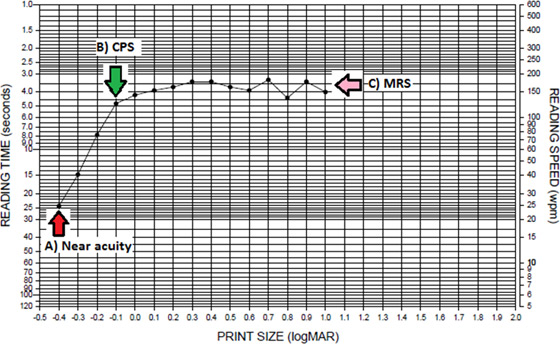IOL Services - Functional Reading Ability
Background
In addition to near acuity, maximum reading speed (MRS)1 and critical print size (CPS)2 provide additional information on visual performance for patients implanted with presbyopia-correcting intraocular lenses (PCIOLs).3 Reading speed is usually relatively constant for print larger than the CPS; where the CPS is defined as the smallest print size below which the reading speed starts to decline sharply.4
Uses
These metrics provide information regarding functional reading ability and have been used to differentiate between different PCIOLs platforms5 or to compare reading performance between PCIOLs and monofocal lenses.6
Conventional tests
Common tests used to measure functional reading ability include the Minnesota Near Reading (MNRead) chart (Lighthouse Low Vision Products, NY, USA)2,6 and the Radner reading chart (Precision Vision; La Salle, IL, USA)5. Both charts present short sentences at each print size, therefore, any hesitation (subject) or timing inaccuracies (observer) can result in a large change in the apparent measurement. The charts use print sizes designed for a fixed distance of 40 cm, which require conversion for different working distances. In addition, both charts are presented at a single level of contrast only (typically at 90 %).
Our approach
We are currently utilising longer validated reading speed texts7 in digital form to allow resizing and contrast modification to better differentiate between different IOL designs.

Figure 1. A typical plot of reading speed as a function of print size. This graph is used to estimate reading ability metrics such as near acuity (A), critical print size - CPS (B) and maximum reading speed - MRS (C).
References
- Hutz WW, Eckhardt HB, Rohrig B & Grolmus R. Intermediate vision and reading speed with array, Tecnis, and ReSTOR intraocular lenses. J Refract Surg. 2008; 24:251-256.
- Ito M & Shimizu K. Reading ability with pseudophakic monovision and with refractive multifocal intraocular lenses: comparative study. J Cataract Refract Surg. 2009; 35:1501-1504.
- Gupta N, Wolffsohn JS & Naroo SA. Comparison of near visual acuity and reading metrics in presbyopia correction. J Cataract Refract Surg. 2009; 35:1401-1409.
- Legge GE & Bigelow CA. Does print size matter for reading? A review of findings from vision science and typography. J Vis. 2011; 11:8:1-22.
- Hutz WW, Eckhardt HB, Rohrig B & Grolmus R. Reading ability with 3 multifocal intraocular lens models. J Cataract Refract Surg. 2006; 32:2015-2021.
- Harman FE, Maling S, Kampougeris G, et al. Comparing the 1CU accommodative, multifocal, and monofocal intraocular lenses: a randomized trial. Ophthalmology. 2008; 115:993-1001e2.
- Hahn GA, Penka D, Gehrlich C, et al. New standardised texts for assessing reading performance in four European languages. Br J Ophthalmol. 2006; 90:480-484.
